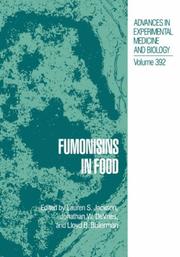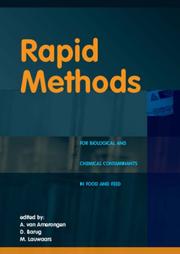| Listing 1 - 6 of 6 |
Sort by
|

ISBN: 0306452162 1489913815 1489913793 Year: 1996 Volume: 392 Publisher: New York ; London Plenum Press
Abstract | Keywords | Export | Availability | Bookmark
 Loading...
Loading...Choose an application
- Reference Manager
- EndNote
- RefWorks (Direct export to RefWorks)
Fumonisins --- Toxicology --- Congresses --- Corn as food --- Contamination --- Feeds --- Fumonisins - Toxicology - Congresses. --- Corn as food - Contamination - Congresses. --- Feeds - Contamination - Congresses. --- Food contamination. --- Carcinogens, environmental --- Mycotoxins

ISBN: 9780387464121 0387464115 9780387464114 9786612923845 1282923846 0387464123 Year: 2007 Publisher: New York : Springer,
Abstract | Keywords | Export | Availability | Bookmark
 Loading...
Loading...Choose an application
- Reference Manager
- EndNote
- RefWorks (Direct export to RefWorks)
Feedstuff is any of the constituent nutrients of an animal ration. The plants used in feed, such as grains, oils seeds, and nuts root crops, are susceptible to mycotoxin contamination. Mycotoxins in Feedstuffs provides an overview of mycotoxins in feedstuff and ingredients. It discusses whether a feedstuff ingredient is predisposed for a mycotoxin contamination and lists the degree of contamination, the concentration of the toxins and the country of origin and/or detection of the contaminated food. About the Author: Dr. Martin Weidenbörner is a professor emeritus of the Institute for Applied Microbiology of Germany.
Chemistry. --- Food Science. --- Agriculture. --- Microbiology. --- Food science. --- Chimie --- Agriculture --- Microbiologie --- Feeds --- Mycotoxins. --- Contamination. --- Feeds. --- Feeds -- Contamination. --- Mycotoxins --- Health & Biological Sciences --- Earth & Environmental Sciences --- Animal Sciences --- Biomedical Engineering --- Contamination --- Fungal toxins --- Feed contamination --- Food --- Biotechnology. --- Fungal metabolites --- Microbial toxins --- Mycotoxicoses --- Toxigenic fungi --- Food contamination
Book
ISBN: 0444995595 Year: 1986 Volume: 22 Publisher: Amsterdam Oxford New York Elsevier
Abstract | Keywords | Export | Availability | Bookmark
 Loading...
Loading...Choose an application
- Reference Manager
- EndNote
- RefWorks (Direct export to RefWorks)
Aliments--Contamination --- Besmet voedsel --- Besmetting van het voedsel --- Contamination des aliments --- Contamined food --- Food contamination --- Food--Contamination --- Foods [Contaminated ] --- Voedsel [Besmet ] --- Voedsel--Besmetting --- Microbiologie --- Microbiology --- Identification --- identification --- Moisissure --- Moulds --- Produit alimentaire --- foods --- Aliment pour animaux --- feeds --- Hygiène des aliments --- Food hygiene --- Biodégradation --- Biodegradation --- Monilia --- Mucor --- Feeds --- Filamentous fungi --- Food contamination. --- Moniliales --- Mucorales --- Contamination. --- Identification. --- Contamination --- identification. --- Biodegradation. --- Champignon filamenteux --- Hyphomycete --- Feeds contamination --- HYPHOMYCETES --- MUCORALES --- FOOD CONTAMINATION --- ISOLATION AND PURIFICATION
Book
ISBN: 1461408024 9786613443700 1283443708 1461408032 Year: 2012 Publisher: New York : Springer,
Abstract | Keywords | Export | Availability | Bookmark
 Loading...
Loading...Choose an application
- Reference Manager
- EndNote
- RefWorks (Direct export to RefWorks)
Mycotoxins are substances produced from fungal secondary metabolic processes. They impair animal health, thereby causing great economic losses of livestock through disease. Livestock come into contact with mycotoxins through contaminated feedstuff. Feedstuff is any of the constituent nutrients of an animal ration. The plants used in feed, such as grains, oil seeds, nuts, and root crops, are susceptible to mycotoxin contamination. Mycotoxins in Feedstuffs lists (in the style of a dictionary) feeds which have been reported to have been contaminated with mycotoxins, including data on the degree of contamination, the concentration of the toxins, and the country of origin and/or detection of the contaminated feed. This second edition will feature: - More than 180 new publications concerning mycotoxins in feedstuffs. - A more efficient organization of the content, making the book easier to use in daily practice. - A single-chapter overview of mycotoxins in the corresponding feedstuffs.
Feeds -- Contamination. --- Feeds. --- Mycotoxins. --- Feeds --- Mycotoxins --- Agriculture --- Health & Biological Sciences --- Earth & Environmental Sciences --- Biomedical Engineering --- Animal Sciences --- Contamination --- Toxicology. --- Animal feeds --- Animal rations --- Animals --- Domestic animals --- Feed --- Feeding and feeding stuffs --- Feeding stuffs --- Feedingstuff --- Feedstuff --- Fodder --- Livestock --- Livestock rations --- Rations, Animal --- Rations, Livestock --- Fungal toxins --- Feeding and feeds --- Chemistry. --- Food --- Agriculture. --- Plant biochemistry. --- Food Science. --- Plant Biochemistry. --- Biotechnology. --- Farm supplies --- Animal feeding --- Fodder banks --- Fungal metabolites --- Microbial toxins --- Mycotoxicoses --- Toxigenic fungi
Book
ISBN: 9783642007255 9783642007248 3642007244 3642007252 9786612831270 1282831275 Year: 2010 Publisher: Berlin ; Heidelberg : Springer-Verlag,
Abstract | Keywords | Export | Availability | Bookmark
 Loading...
Loading...Choose an application
- Reference Manager
- EndNote
- RefWorks (Direct export to RefWorks)
Mycotoxins are made by different biosynthetic pathways, and they have an extremely wide range of pharmacological effects. This book will update readers on several cutting-edge aspects of mycotoxin research, including topics such as: new analytical methods for detection; the adoption of an ancient Mexican process for detoxification of aflatoxins; mycotoxin management in Ireland, Lithuania and South America; mycotoxin reduction through plant breeding and integrated management practices; and natural aflatoxin inhibitors from medicinal plants. Further contributions examine ochratoxins, selected trichothecenes, zearalenone, and aflatoxin-like gene clusters, as well as sclerotial development in Aspergillus flavus and A. parasiticus. Of particular interest are the chapters on the potential use of mycotoxins as bioweapons. This book will stimulate new thinking on the need to develop therapeutic as well as preventative interventions to reduce the toxicological threat of mycotoxins.
Life Sciences. --- Eukaryotic Microbiology. --- Food Science. --- Agriculture. --- Pharmacology/Toxicology. --- Life sciences. --- Toxicology. --- Food science. --- Microbiology. --- Sciences de la vie --- Toxicologie --- Agriculture --- Microbiologie --- Mycotoxins. --- Food contamination. --- Feeds --- Biological weapons. --- Animal Feed --- Biological Warfare Agents. --- Food --- Food Microbiology. --- Contamination. --- microbiology. --- toxicity. --- Feeds -- Contamination. --- Mycotoxins --- Food contamination --- Biological weapons --- Food Microbiology --- Biological Warfare Agents --- Microbiology --- Environmental Microbiology --- Weapons --- Crops, Agricultural --- Biology --- Food Contamination --- Food and Beverages --- Weapons of Mass Destruction --- Toxins, Biological --- Food Technology --- Biological Factors --- Food Safety --- Biological Science Disciplines --- Food Industry --- Environmental Pollution --- Public Health --- Manufactured Materials --- Technology, Industry, Agriculture --- Industry --- Chemicals and Drugs --- Technology, Industry, and Agriculture --- Natural Science Disciplines --- Environment and Public Health --- Health Care --- Disciplines and Occupations --- Microbiology & Immunology --- Toxicology & Public Health --- Health & Biological Sciences --- Contamination --- Bacteriological weapons --- Biological warfare agents --- Bioweapons --- Contaminated food --- Foods, Contaminated --- Fungal toxins --- Pharmacology. --- Biochemistry. --- Biochemistry, general. --- Biotechnology. --- Weapons of mass destruction --- Biosecurity --- Contamination (Technology) --- Food adulteration and inspection --- Fungal metabolites --- Microbial toxins --- Mycotoxicoses --- Toxigenic fungi

ISBN: 9076998531 9086865380 9789086865383 9789076998534 Year: 2005 Publisher: Leiden ;Boston Brill | Wageningen Academic
Abstract | Keywords | Export | Availability | Bookmark
 Loading...
Loading...Choose an application
- Reference Manager
- EndNote
- RefWorks (Direct export to RefWorks)
The rapid and reliable detection of biological and chemical contaminants is extremely important in managing the safety of food and feed. "Rapid Methods" is a comprehensive reference resource for anyone interested in this subject. Developments in analytical techniques have led to the emergence of a wide range of rapid methods to complement the traditional methods. At the same time, the importance of method validation, proficiency testing, quality management, sampling and legislation have all become more widely recognised. "Rapid Methods" presents a firm base and structured framework for considering rapid analysis of biological and chemical contaminants in food and feed. The various chapters concentrate on the state of the art in rapid methods in regards to: legislation, sampling, method validation, microbial pathogens, biological materials like GMOs and allergens, toxins like bacterial food poisoning toxins, marine toxins and biogenic amines, chemicals like veterinary drugs, pesticides and dioxins. The editors firmly believe that the very nature of the theme, the excellence of the peer-reviewed papers and the holistic approach chosen in this book will draw an audience from both the food and feed industry as well as from the scientific community.
Feeds -- Contamination -- Congresses. --- Feeds -- Toxicology -- Congresses. --- Food -- Safety measures -- Congresses. --- Food -- Toxicology -- Congresses. --- Food adulteration and inspection -- Congresses. --- Microbial contamination -- Congesses. --- Environmental Pollution --- Food Safety --- Crops, Agricultural --- Food Technology --- Investigative Techniques --- Analytical, Diagnostic and Therapeutic Techniques and Equipment --- Public Health --- Food --- Food Industry --- Food and Beverages --- Environment and Public Health --- Industry --- Technology, Industry, and Agriculture --- Health Care --- Technology, Industry, Agriculture --- Animal Feed --- Food Contamination --- Food Analysis --- 579.67 --- 57.083 --- 641.1 --- 664.004.58 --- RELKT-139051 --- RELLT-SEA --- analytische chemie (scheikunde) --- contaminanten --- microbiologie --- nanotechnologie --- pathogenen --- recht (wetgeving) --- stalenopname --- toxiciteit --- voedingsmiddelenanalyse --- voedingsmiddelenchemie --- voedingsmiddelencontrole --- voedingsmiddelenmicrobiologie --- voedingsmiddelentechnologie --- voedselveiligheid --- voedselvergiftiging --- Microbiologie --- Tests --- Voedingshygiëne --- Voedingsmiddelenanalyse --- Food microbiology --- Voedingsmicrobiologie --- levensmiddelen --- Basic Sciences. Chemistry --- Analytical Chemistry --- Analytical Chemistry. --- 579.67 Food microbiology --- Food adulteration and inspection --- Microbial contamination --- Feeds --- Safety measures --- Toxicology --- Contamination --- Animal feeds --- Animal rations --- Animals --- Domestic animals --- Feed --- Feeding and feeding stuffs --- Feeding stuffs --- Feedingstuff --- Feedstuff --- Fodder --- Livestock --- Livestock rations --- Rations, Animal --- Rations, Livestock --- Farm supplies --- Animal feeding --- Fodder banks --- Contamination, Microbial --- Contamination by microorganisms --- Microbiological contamination --- Contamination (Technology) --- Biological decontamination --- Sanitary microbiology --- Foods --- Primitive societies --- Dinners and dining --- Home economics --- Table --- Cooking --- Diet --- Dietaries --- Gastronomy --- Nutrition --- Feeding and feeds --- FOOD CONTAMINATION --- FOOD MICROBIOLOGY --- DRUG RESIDUES --- ANALYSIS
| Listing 1 - 6 of 6 |
Sort by
|

 Search
Search Feedback
Feedback About UniCat
About UniCat  Help
Help News
News